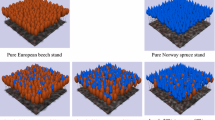Abstract
One way to increase the productivity of artificial forestation is to control the density and position of trees relative to each other. Thus, the optimal planting schemes to obtain the maximum stock of wood of a given diameter must be found. A simulation model was used for a comparative analysis of the productivity of spruce stands with different planting schemes. Rectangular and square planting patterns with different initial forest-stand densities are considered. The stock of small (trunk diameter 6–13 cm), medium (14–23 cm), and large (over 24 cm) wood was calculated with respect to the row spacing and the pitch of trees planted on a site 40 × 40 m in size. In the selection of the optimal planting scheme, it is taken into account that there are various seedlings that differ in competitiveness. It is shown that the square planting scheme is optimal when the initial number of seedlings is the same. The optimal distances between trees for the growth of small, medium, and large wood with a square planting pattern were 1.4 × 1.4 m, 2.4 × 2.4 m, and 4 × 4 m, respectively. The spruce stand reached the specified qualitative characteristics corresponding to small, medium, and large wood in 36, 68, and 155 years. Thus, it has been shown that different initial planting densities are required in order to obtain the maximum wood stock for different size classes: the larger the grown wood is, the lower is the optimal planting density.












Similar content being viewed by others
REFERENCES
Berezovskaya, F.S. and Karev, G.P., Modeling of dynamics of wood stands, Sib. Lesn. Zh., 2015, no. 3, pp. 7–19.
Fang, S., Xu, X., Lu, S., and Tang, L., Growth dynamics and biomass production in short-rotation poplar plantations: 6-year results for three clones at four spacings, Biomass Bioenergy, 1999, vol. 17, no. 5, pp. 415–425.
GOST (State Standard) 17462-84: Forest Industry Production. Terms and Definitions, Moscow: Izd. Standartov, 2000.
Grabarnik, P.Ya., Modeling of spatial structure of wood stands, in Modelirovanie dinamiki organicheskogo veshchestva v lesnykh ekosistemakh (Modeling of Organic Matter Dynamics in Forest Ecosystems), Moscow: Nauka, 2007, pp. 132–146.
Karev, G.P. and Skomorovskii, Yu.I., Mathematical models of wood stand destruction, Lesovedenie, 1997, no. 4, pp. 14–20.
Khil’mi, G.F., Teoreticheskaya biogeofizika lesa (Theoretical Biogeophysics of Forest), Moscow: Akad. Nauk SSSR, 1957.
Kolobov, A.N., Modeling the spatio-temporal dynamics of wood communities: an individually oriented approach, Lesovedenie, 2014, no. 5, pp. 72–82.
Kolobov, A.N. and Frisman, E.Ya., Individual-based model of spatio-temporal dynamics of mixed forest stands, Ecol. Complex, 2016, vol. 27, pp. 29–39.
Kolobov, A.N. and Frisman, E.Ya., Evaluate the initial spatial structure and heterogeneity of the composition for spruce and larch stands on real data self-thinning of even-aged stands, Ecol. Complex, 2018, vol. 34, pp. 89–99.
Koryakin, V.N., Spravochnik dlya ucheta lesnykh resursov Dal’nego Vostoka (Handbook for Registration of Forest Resources of Far East), Khabarovsk: Dal’nevost. Nauchno-Issled. Inst. Lesn. Khoz., 2010.
Larocque, G.R., Performance and morphological response of the hybrid poplar DN-74 (Populus deltoids × nigra) under different spacings on a 4-year rotation, Ann. For. Sci., 1999, vol. 56, no. 4, pp. 275–287.
Lesnaya entsiklopediya (Forest Encyclopedia), Vorob’ev, G.I., Ed., Moscow: Sovetskaya Entsiklopediya, 1986, vol. 2.
Merzlenko, M.D. and Babich, N.A., Teoriya i praktika iskusstvennogo lesovosstanovleniya (Theory and Practice of Artificial Reforestation), Arkhangelsk: Sev. Fed. Univ., 2011.
Pisarenko, A.I. and Merzlenko, M.D., Sozdanie iskusstevennykh lesov (Creation of Artificial Forests), Moscow: Agropromizdat, 1990.
Priputina, I.V., Frolova, G.G., and Shanin, V.N., Computer-based selection of optimal planting schemes of forests, Komp’yut. Issled. Model., 2016a, vol. 8, no. 2, pp. 333–343.
Priputina, I.V., Frolova, G.G., Bykhovets, S.S., Shanin, V.N., Lebedev, V.G., and Shestibratov, K.A., Modeled productivity of forest plantations with different schemes of spatial distribution of trees, Matem. Biol. Bioinf., 2016b, vol. 11, no. 2, pp. 245–262.
Reineke, L.H., Perfecting a stand-density index for even-aged forests, J. Agric. Res., 1933, vol. 46, no. 7, pp. 627–638.
Shutov, I.V., Maslakov, E.L., and Markova, I.A., Lesnye plantatsii: uskorennoe vyrashchivanie eli i sosny (Forest Plantations: Accelerated Growing of Spruce and Pine), Moscow: Lesnaya Prom-st’, 1984.
Zagreev, V.V., Sukhikh, V.I., Shvidenko, A.Z., Gusev, N.N., and Moshkalev, A.G., Obshchesoyuznye normativy dlya taksatsii lesov (All-Union Standards for Forest Taxation), Moscow: Kolos, 1992.
Funding
This work was performed within the framework of the state assignment of the Institute for Comprehensive Analysis of Regional Problems of the Far East Branch of the Russian Academy of Sciences and with financial support from the Russian Foundation for Basic Research (project no. 18-04-00073 a).
Author information
Authors and Affiliations
Corresponding authors
Ethics declarations
Conflict of interests. The authors declare that they have no conflicts of interest.
Statement on the welfare of humans or animals. This article does not contain any studies involving animals performed by any of the authors.
Rights and permissions
About this article
Cite this article
Kolobov, A.N., Frisman, E.Y. Modeling Analysis of the Productivity of Artificial Spruce Stands with Different Planting Schemes. Biol Bull Rev 11, 293–302 (2021). https://doi.org/10.1134/S207908642103004X
Received:
Revised:
Accepted:
Published:
Issue Date:
DOI: https://doi.org/10.1134/S207908642103004X




